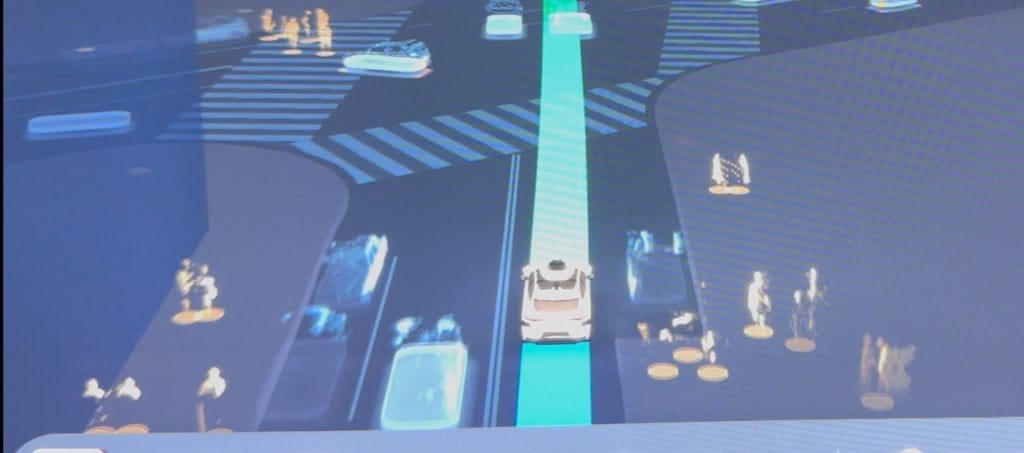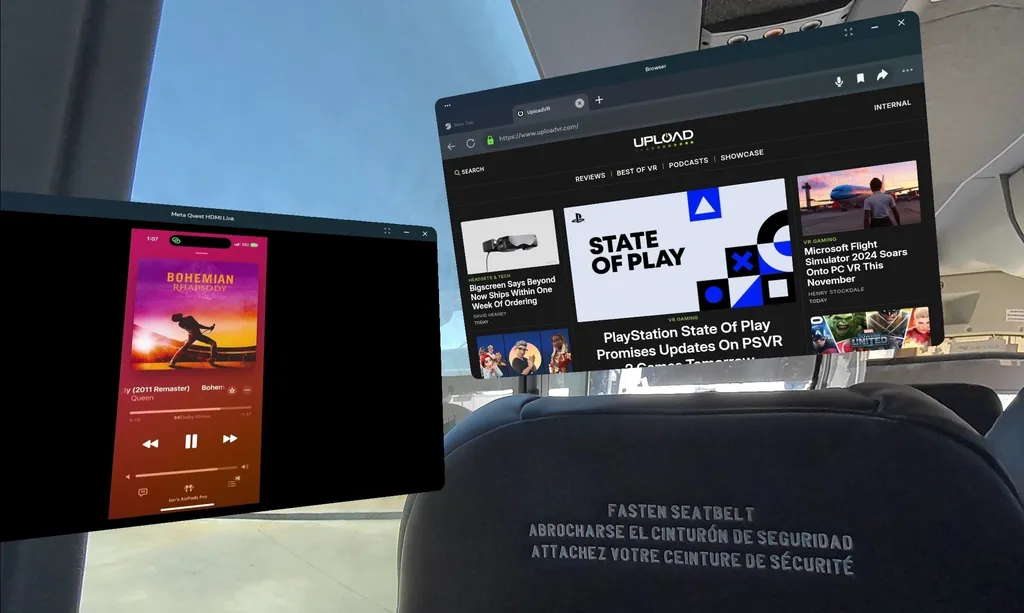This article was written in a head-mounted display in a bus driving across California from Los Angeles to San Jose.
I used a folding pocket keyboard to type into the headset's web browser. I brought my phone display into Horizon OS but left its audio running through bluetooth earbuds. This allowed me to listen to my music continuously, outside and inside the headset, from a list called Virtual Reality. I listened to songs from Beat Saber, Walkabout Mini Golf, I Expect You To Die, and Pistol Whip, mixed in with classics like Bohemian Rhapsody from Queen.
The noise cancellation on the wireless earbuds tuned out the children playing in the seats behind me. An app on my headset carried the wired HDMI connection from my phone, allowing me to use it off and on throughout my work.
This is the way I've dreamed of working for some time and it's finally becoming possible.
25 Years Of Journalism & Personal Computing
My work in journalism started in high school almost 25 years ago, beginning on the iMac G3 I received as a gift from family and continuing to the iPhone in college I used to document everything. For the last 15 years, I've found myself sharing my iPhone's always-on Internet connection to every other device I own to work and play on the go.
That's still true here with the Quest 3 I used on this trip, and major changes come together in the device that Meta has been building toward for many years which make it an effective personal computer. Together, the latest moves make working in VR an opportunity to achieve a sense of focus, alongside the freedom to work from anywhere, that's typically only reserved for bosses working from their expensive homes or a private office.
Mixed Reality On Driverless Roads
Before the bus ride, I took my son to see Transformers One in downtown Los Angeles. On our way into the movie theater, we spotted a self-driving car doing a ride pickup.
I pulled out my phone during a bathroom break in the movie and messaged the world looking for an invite to test the service. At the end of the movie, when I checked my phone again, a sign-up code was waiting for me in my direct messages. So we exited the theater to summon a real-life autobot. I enjoyed my ride so much, on Monday I summoned another to take me from the apartment to Union Station. Riding in an autocar is obviously different from a traditional human-driven ride service. But how exactly?
The display between the seats shows the car’s detailed understanding of the environment around it, with outlines of people, cars, route and even rear-view lights on the cars ahead of us all blinking into existence on the tiny screen.

Have you lamented the social oddity of being picked up by drivers who don't necessarily feel at ease with the social interaction that comes with the job? I'd typically use my phone during such travel times to respond to coworkers on Slack, and yet, depending on the occasion, I generally love the conversations I have with Uber or Lyft drivers too. I get an unexpected window into someone else's life whenever I do, and I adore those moments of discovery as we take a trip together through a co-op game called Traffic.
In the self-driving car, though, human social interaction is absent and my life is already in the hands of the company driving me. I'm a passenger with no driver, and because of that the only thing that kept me from working in my HMD across that particular ride was the fact that it was just a 12 minute trip. Most of my time would've been spent getting my virtual lighting just right and my simulated windows arranged in space around me at just the right spots.
On the human-driven bus, though, the ride is more than eight hours long. The seats don't have the tray tables to support the food pricing models used on aircraft. The space for my legs seems ever so slightly roomier than economy class on a modern flight. The bus service charged UploadVR nearly $70 for the ticket because it includes the seat adjoining mine, allowing me to stretch out next to my baggage and equipment pile.
A friend suggested I should have flown. I could have gotten my flight much earlier, then had Uber or Lyft take me from San Francisco to San Jose. That route, however, would have likely cost UploadVR much more money and left me in an airport for 2 to 3 hours working through security and sitting in predominantly public spaces being stared at while I work. Instead, I boarded the bus about 15 minutes early (straight from my auto-ride) and, by the time we were on the road, the first sentence was being tapped into this page.
My bus pulled out at 12:40 pm Pacific time and my work stopped when the sun went down around 7:30 that night when my hand tracking failed in the unlit vehicle.
I turned a travel day into a work day.
Social Change From VR & Automation
Last week, my colleague David Heaney enjoyed the true sense of darkness delivered by the Apple Vision Pro's micro-OLED displays as he worked across half a dozen flights taking him from London to Austin, Texas and back. When he got to Texas, he put his eyeballs inside a barely functional headset from Immersed. Then he wrote about his experience.
While Apple's decision to focus on micro-OLED displays offers you true darkness as a backdrop for the work you do in VR, the headset has also been priced out of reach for most people for the same reason. Meta headsets are cost cutters, however, and its designers make compromises to ship to more people at lower prices more quickly than the competition.
Apple will likely get to lower prices too. Meta Quest headsets, though, just completed a five-year journey from launch in 2019 to Quest 3S seeing the self-contained HMD become a low cost companion for almost any other computing device you own. And this year, the company-formerly-known-as-Facebook has steadily opened up the software running that system to allow it to do almost anything, except operate it without a Meta account.
If you spend $300 for a Quest 3S (assuming the leaks are real) and used it with a $200 phone and the right USB hubs and HDMI connectors, you could have a private office with an Internet connection, phone, and unlimited desktop space anywhere in the world. Simply set up a room with a unique code in a place like Walkabout Mini Golf or Puzzling Places, and then share that code with the people you might want to interact with during a given workday.
If someone you work with wants you to do something, they can use the code to find you in VR and talk to you face to face. Otherwise, everything else happening in the world at any given moment, including any other work-related tasks, needs to flow through whichever windows you have pulled up inside that headset.
For the last 15 years, everyone assumed you'd be available on your iPhone or Android. VR changes that because people can no longer make that assumption, because it's a place you go without your phone. Sure, my paragraph above is still science fiction to suggest you'll be able to take office hours in a VR gaming lobby. I've tried it, though, and I contend anyone resistant to putting on an HMD for work hasn't experienced focus and control like that. Sure the weight sucks and fixed focus optics do too, but engineers have shown paths to solutions for those problems.
Employers don't have workplaces or policies to encourage working anytime, anywhere, from an HMD. Part of the problem is that, from the rise of iPhone to the pandemic, workers have learned 40 hours a week working a job doesn't actually feel like just eight hours per day. No, you have to tack on an hour each way operating a car to an office and, yet, when you clock out, are you not also followed by unbillable messages in email, Slack, text messages and other routes that suck up your personal time without payment? What happened to the concept of "clocking out"?
Headsets don't "solve" these problems. In fact, the technology could exacerbate them for workplaces which don't set strong barriers on the lines of communication between personal and work life. For some workplaces and some workers, however, a portable head-mounted display could be precisely the tool needed to let them put balance back into their lives so they can work when, where, and how they want.
When you're done with work, take the headset off and forget about your job till tomorrow. Isn't that the dream?
Instead, the corporate world is moving in the direction of AI generation to fill roles as executives deploy return to office policies to make use of their real estate and avoid the bad press of major layoffs. What happens when major corporations and startups alike all excise the most effective workers from their companies because they refuse to return to the office?
We're about to find out how super low-cost portable, private, head-mounted displays fit into that trend.
For me, an eight hour bus ride is now an opportunity to lock out all distractions and get my workday done while still available to my coworkers the whole time.






























